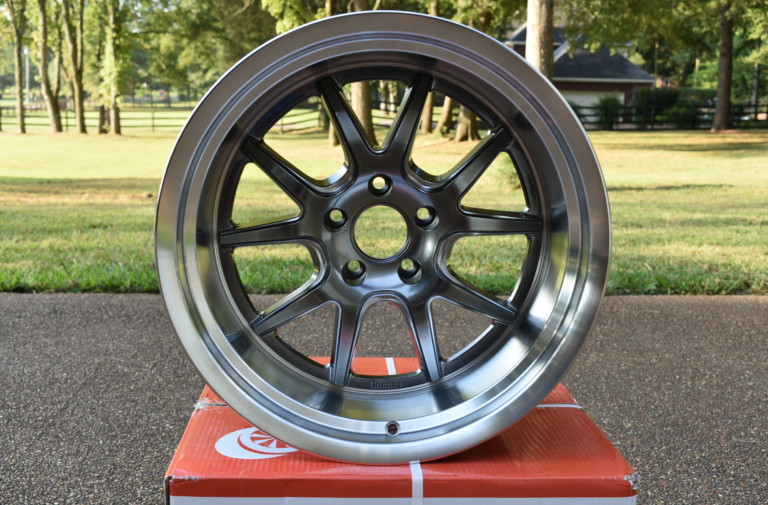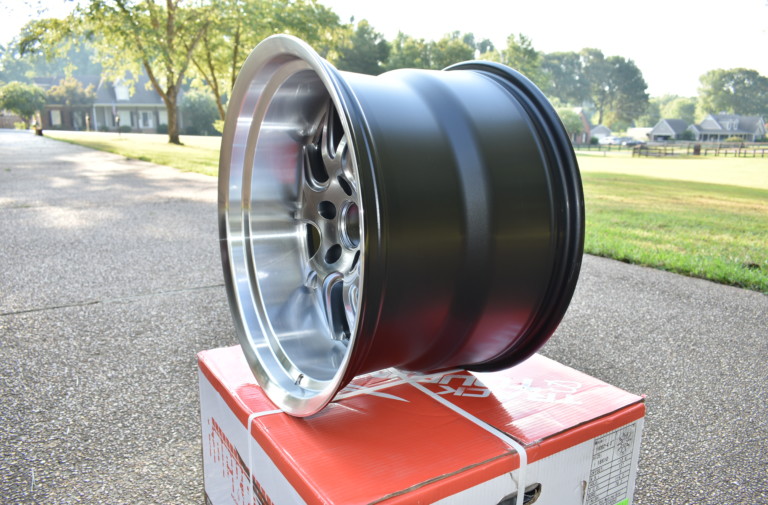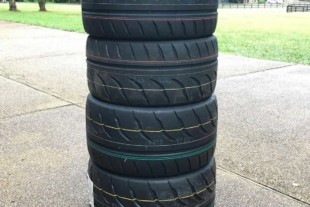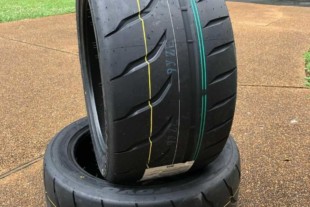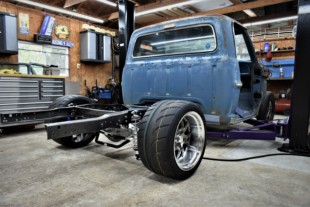So far in the Project F Word saga, we’ve brought you along as we upgraded suspension, transmission, and brake components. But our project 1969 F-100 can’t get very far with its new parts without wheels and tires to roll on! In choosing the perfect wheel and tire combo, there were things to consider: we needed to choose options that fit with our big Baer brakes, and were also ideal for street and autocross duty. Plus, they had to look good.
We set our sights on Rocket Racing Wheels, because, well, look at them! We were also impressed with the development process. We’ll get to that in just a bit.
Picking Our Poison
We decided on the Rocket Attack Hyper Shot Wheels, 18×10 in the front (TTR16-816550), and 18×12 in the rear (TTR16-826560). The front wheels feature 5-inch backspacing. The rear wheels 6 inches of backspacing. They have a 5×4.5 bolt pattern, typical of a Mustang, and perfect for our F-100. Our friends at Baer had encouraged us to choose our wheels before deciding on brakes to make sure we were getting the outward looks we wanted as well as the stopping power we needed.

The hub we chose from Baer features two sets of bolt holes — the 5×4.5-inch Ford Mustang bolt pattern and the 5×5.5-inch Ford truck pattern.
You can read more about the Baer spindles and hubs chosen here, but the hub we chose from Baer features two sets of bolt holes — the 5×4.5-inch Ford Mustang bolt pattern and the 5×5.5-inch Ford truck pattern. We chose to run wheels with the smaller 5×4.5-inch pattern since Project F Word won’t need the higher load capacity of big truck wheels, and there was a greater selection of wheel designs, sizes, and backspacing available to us. 
We also consulted with QA1 regarding the plans for our wheels. Seeing as our F100 is equipped with QA1’s F100 Coilover Conversion Kit, we wanted to ensure proper fitment, and they were all for our choice of wheels. “QA1 has used Rocket Racing ‘Attack’ wheels on several QA1 builds,” QA1’s Dave Kass told us. “Not only are they a great looking wheel, but their sizing and backspacing options are tremendous. We’re always able to find that perfect wheel to compliment any project we’re working on.”
Features and Benefits
The Rocket Attack Hyper Shot wheels feature a Hyper Shot painted center face and precision-machined outer lip, finished in a low-maintenance clear coat. The wheels were designed with track styling in mind, but they also perform well on the street during daily driving duties. Additionally, they’re reasonably priced — the exact wheels we chose retail in the mid-$400 range.
The wheels’ one-piece design eliminates the need for those leaky bolts, added maintenance, or adjustments required by 3-piece wheel designs. Rocket kept caliper clearance in mind during the design process, granting the wheels generous clearance so that customers can take advantage of modern brake systems.
Each wheel comes with a standard dome machined center cap (1-inch tall) but there is also an optional flat center cap with machined aluminum flush mount if that’s more your style. Custom wheel finish options are available so you can pick the perfect match for your project.
Development Process
This is where things get especially interesting. Rocket utilizes a process called dual-direction, flow-form, semi-forged technology allowing the creation of wheels with similar weight and metal strength characteristics to that of forged metal. Rocket is the only company that utilizes this technology, not to be confused with simple single-direction flow forming, which is used commonly in the wheel industry. We caught up with the owner of Rocket Racing Wheels, David Coker, at SEMA a few years back, and he explained the process. You can watch the video below.
The dual-direction method allows the cast center to be moved within a wide range of offsets inside the spun forged outer, offering nearly infinite flexibility. Basically, it’s a modular process utilizing a single outer rim mold that is then fit with a variety of centers for endless combinations. The result is the ability to provide options that were once only available in expensive, multi-piece wheel designs. Because of this, Rocket is able to produce wheels with a variety of widths and backspacings all from a single mold. The need for only a single mold translates to monetary savings, which are passed on to the customer. Compare this to the typical single-direction flow-forming process, which requires an individual mold for each and every wheel created.
The method also adds strength and delivers weight comparable to that of fully forged wheels, though they’re still technically partially “cast.” The construction process includes pressurized flow forming which ensures a densely packed aluminum product that is free of porosity. This ensures a stronger wheel than those made from traditional casting methods.
Rocket’s development process and proprietary technology allows the production of wheel sizes ranging from 18×7 inches to 18×12 inches with up to four individual back spacings from one mold.
Tire Choice
When it came time to choose rubber to wrap around our new, badass wheels, we turned to our friends at Toyo. We need a tire that will perform well on the street with a little bit of autocross action, so they directed us to their Toyo R888R tires.
Project F Word’s owner, Ford Muscle staffer Ivan Korda, has some experience with the Toyo R888R tire, seeing as it was the tire of choice on his last project, Project Boosted Coyote.
He told us the following in the planning stages of this project. “I would prefer Toyo since I have used their R888R tires with great success on the Mustang. It’s an awesome tire.”
So the decision was made. We ordered a pair of 275/35ZR18 tires for the front with a pair of 305/35ZR18s for the rear.
Features and Benefits
The Toyo Proxes R888R is a variation of Toyo’s Proxes R888 tire, with a new tread design and improved contact patch, optimized to improve dry traction in braking, acceleration, and cornering. The contact patch is flanked by massive tread blocks on the outside tread for maximum lateral grip, allowing for improved cornering. The wide center rib improves directional stability and offers precise steering response. Finally, a water evacuation channel assists in providing traction when driving in wet conditions.
The tires are made from a high-grip race compound, which is designed to reach optimal operating temperature quickly and provide performance on a consistent basis. This compound was also chosen as a means to improve grip for excellent performance in the corners.
To say we’re excited to try this new wheel and tire combination out and put it through the paces would be an understatement, but we still have a bit of work to do before we can make that happen. When we do, we’ll bring you along for the ride. Stay tuned — in the next installment, we’ll be talking about the Strange rearend components chosen for our F-100!





